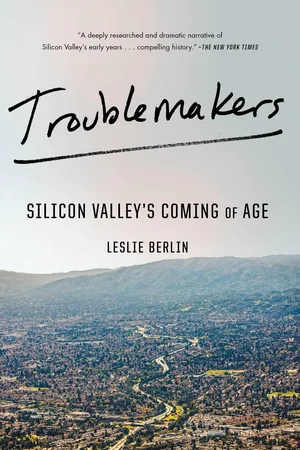
- 512 pages
- English
- ePUB (mobile friendly)
- Available on iOS & Android
About this book
Acclaimed historian Leslie Berlin's "deeply researched and dramatic narrative of Silicon Valley's early years…is a meticulously told…compelling history" ( The New York Times ) of the men and women who chased innovation, and ended up changing the world. Troublemakers is the gripping tale of seven exceptional men and women, pioneers of Silicon Valley in the 1970s and early 1980s. Together, they worked across generations, industries, and companies to bring technology from Pentagon offices and university laboratories to the rest of us. In doing so, they changed the world. "In this vigorous account…a sturdy, skillfully constructed work" ( Kirkus Reviews ), historian Leslie Berlin introduces the people and stories behind the birth of the Internet and the microprocessor, as well as Apple, Atari, Genentech, Xerox PARC, ROLM, ASK, and the iconic venture capital firms Sequoia Capital and Kleiner Perkins Caufield & Byers. In the space of only seven years, five major industries—personal computing, video games, biotechnology, modern venture capital, and advanced semiconductor logic—were born."There is much to learn from Berlin's account, particularly that Silicon Valley has long provided the backdrop where technology, elite education, institutional capital, and entrepreneurship collide with incredible force" ( The Christian Science Monitor ). Featured among well-known Silicon Valley innovators are Mike Markkula, the underappreciated chairman of Apple who owned one-third of the company; Bob Taylor, who masterminded the personal computer; software entrepreneur Sandra Kurtzig, the first woman to take a technology company public; Bob Swanson, the cofounder of Genentech; Al Alcorn, the Atari engineer behind the first successful video game; Fawn Alvarez, who rose from the factory line to the executive suite; and Niels Reimers, the Stanford administrator who changed how university innovations reach the public. Together, these troublemakers rewrote the rules and invented the future.
Frequently asked questions
- Essential is ideal for learners and professionals who enjoy exploring a wide range of subjects. Access the Essential Library with 800,000+ trusted titles and best-sellers across business, personal growth, and the humanities. Includes unlimited reading time and Standard Read Aloud voice.
- Complete: Perfect for advanced learners and researchers needing full, unrestricted access. Unlock 1.4M+ books across hundreds of subjects, including academic and specialized titles. The Complete Plan also includes advanced features like Premium Read Aloud and Research Assistant.
Please note we cannot support devices running on iOS 13 and Android 7 or earlier. Learn more about using the app.
Information
Notes
Introduction: A Bit Like Love
Arrival: 1969–1971
Prometheus in the Pentagon — Bob Taylor
Table of contents
- Cover
- Dedication
- Epigraph
- Introduction: A Bit Like Love
- Arrival: 1969–1971
- Building: 1972–1975
- Challenges: 1976–1977
- Triumph: 1979–1981
- Transition: 1983–1984
- Conclusion: Wave After Wave
- Postscript: The Troublemakers Today
- Photographs
- Acknowledgments
- Abbreviations Used in Notes Section
- Interviewees
- About the Author
- Notes
- Selected Bibliography
- Index
- Copyright